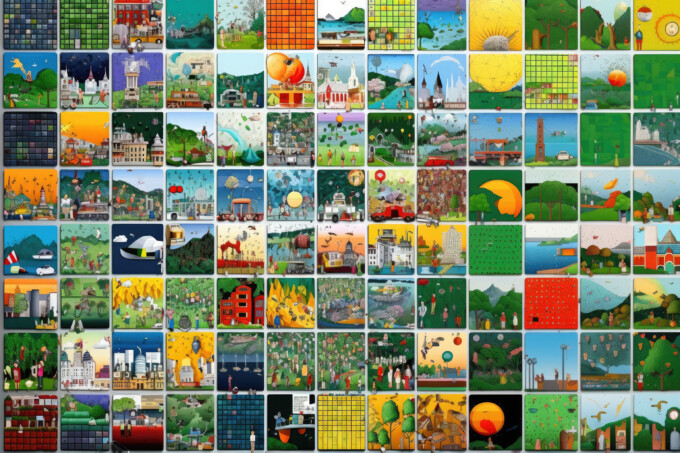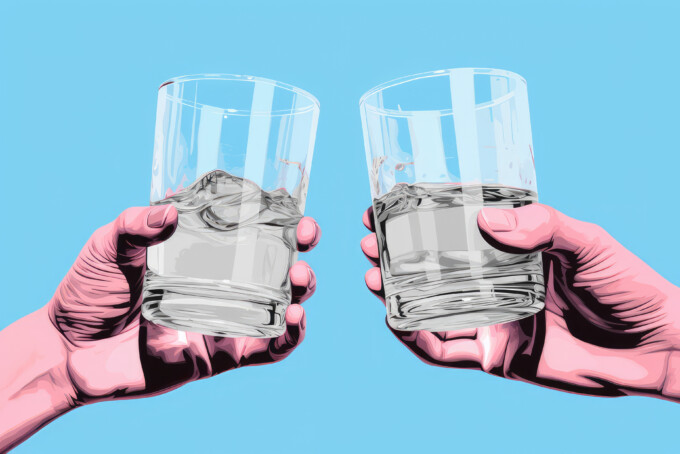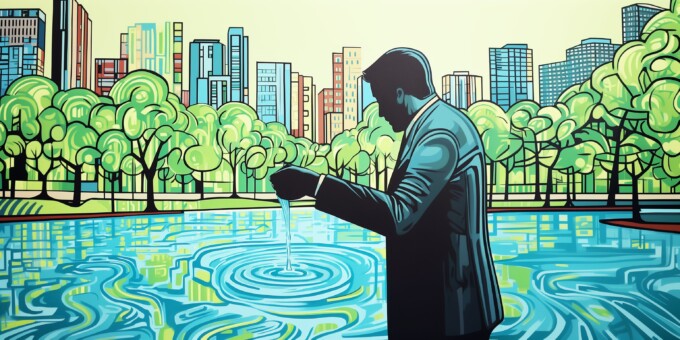Summary: Fresh water isn’t a fixed natural resource we’re passively depleting—it’s something humans actively create through technology and markets. From desalination and wastewater recycling to precision agriculture and atmospheric water generation, innovation continually expands the supply of usable water. Water depletion is not a looming crisis. Demand drives the ingenuity that enables continued water abundance.
Critics warn that humanity is depleting Earth’s finite fresh water supplies through overuse and pollution, urging drastic conservation measures. But this narrative misunderstands what “fresh water” is. Rather than a fixed natural endowment, fresh water is largely a product of human innovation and engineering. As technology advances and economic incentives align, humans continue expanding usable water supplies—turning the ocean, wastewater, and even air into sources of clean, drinkable water.
Environmental alarmists have been issuing stark warnings—humanity is running out of fresh water—for years. “Only 3 percent of the world’s water is fresh water, and two-thirds of that is tucked away in frozen glaciers or otherwise unavailable for our use. . . . At the current consumption rate, this situation will only get worse. By 2025, two-thirds of the world’s population may face water shortages,” declared the World Wildlife Fund. The United Nations warned that “the world may face a 40 per cent shortfall in water availability by 2030.”
Solutions from experts follow a familiar pattern, claiming that the only way to avert a crisis is to adopt radical social and behavioral changes, driven by moral proselytizing, government intervention, or both, to save the water supply. Environmentalists urge people to replace old toilets with low-flow models, avoid running faucets while brushing their teeth or washing dishes, and switch to eating less water-intensive foods. Meanwhile, activists pressure elected officials to impose usage restrictions, ban certain crops in arid regions, and regulate everything from swimming pools to car washes.
Fortunately the economics of water innovation reveals why the apparent scarcity tends to be self-correcting, without requiring us to adopt ascetic lifestyles or perform symbolic actions like picking up dropped ice cubes to water house plants or writing letters to elected officials. Rising prices, not moralizing pleas, lead people to conserve, look for substitutes, recycle resources, and innovate helping to meet demand through alternative means or improved efficiency.
Fresh Water Is a Product of Human Ingenuity
Scarcity is a fundamental feature of our world, but framing discussions about the realities of water scarcity as a matter of running out of fresh water is misleading and reveals an underlying conceptual error. Such a term conjures up images of humanity consuming Earth’s natural endowment of clean water until it’s gone. Fresh water is not a fixed stock nor is it simply out there in nature waiting to be discovered and used. It’s created through human effort.
There is nothing natural about turning on a tap in one’s home and having clean, fresh water flowing out on demand. The water flowing from your tap began its journey as rain, groundwater, or surface water, and it became “fresh” only after passing through treatment plants, filtration systems, and distribution networks. What we call fresh water is best understood as water that has been made usable for human purposes through innovations in technology and infrastructure.
If we had a magic wand to instantly transform seawater, agricultural runoff, or industrial wastewater into pure H2O, the distinction between fresh and other water sources would dissolve. But, human ingenuity, enabled by markets and the price system, address water scarcity as well as any magic would.
As the price of water rises due to increases in demand or decreases in supply, market mechanisms kick in to encourage conservation and efficiency improvements while higher prices make previously uneconomical water sources profitable, thus spurring investment in new technologies and supply sources. Indeed, the full spectrum of solutions to water scarcity is far broader and more diverse than discussions about a monolithic global water crisis suggest. To see that, it helps to disentangle the major uses for fresh water.
Most fresh water withdrawals are for agricultural and industrial uses. According to the 2024 United Nations World Water Development Report, agriculture consumes roughly 70 percent of global fresh water withdrawals, industry accounts for 18 percent, and domestic use makes up the remaining 12 percent. These proportions vary significantly between countries, with larger shares for industry in higher-income countries and for agriculture in least-developed countries.
Agricultural Revolution: Precision and Efficiency
Agriculture’s major share of water use reflects market forces and technology driving remarkable efficiency gains. Israel, where “two thirds of the land is semi-arid or arid and much of the soil is of poor quality [and where] there is a shortage of natural water resources, a scarcity of precipitation” leads in agricultural innovation. Between 1986 and 2008, the country’s crop production increased by 40 percent while agricultural water use remained constant. How? Technologies such as drip irrigation, which apply water directly to plant roots and see 95 percent uptake by avoiding evaporation, are used to water 75 percent of Israel’s crops.
Elsewhere, technologies such as precision agriculture using GPS and sensors are used to enable farmers to apply water exactly where and when it is needed. For example, Valley Irrigation’s smart pivot systems adjust water application based on real-time soil moisture data. Controlled environment agriculture represents an even more dramatic leap in water conservation. AeroFarms’ vertical farming systems use 95 percent less water than field agriculture and produce yields 75 times higher per square foot. Plenty’s indoor farms recycle 99 percent of their water and produce crops year-round regardless of climate. As technology advances, genetic innovations can also reduce agricultural water needs, such as utilizing CRISPR gene editing to enable the development of crops that require less water while maintaining their nutritional value.
What’s Old Is (Made) New Again
Advanced wastewater recycling now produces water that exceeds WHO drinking water quality standards, with water-stressed countries such as Singapore meeting 40 percent of its water needs (and growing) through wastewater recycling. San Diego’s Pure Water program will produce half of the city’s water supply by 2035 from treated wastewater.
Advances in chemistry and materials science promise to make purifying water even cheaper. Graphene oxide membranes developed at the University of Manchester could make desalination far more energy-efficient, while biomimetic membranes inspired by plant cell structures promise breakthrough efficiencies in water filtration and desalination. Furthermore, electrochemical treatment can remove virtually any contaminant from water, enabling the reuse of previously unusable industrial wastewater.
Beyond treatment plants, innovative groundwater management pumps treated wastewater and excess surface water back into underground aquifers, creating massive underground reservoirs for drought protection. These managed aquifer recharge projects globally now store billions of gallons annually, turning natural storage systems into actively managed water banks.
Substituting Away from Fresh Water
Digging into industry’s 18 percent share of fresh water usage reveals that many functions currently performed by water, such as cooling, may not require water at all. Data centers, which consume 5–10 percent of the total US electricity supply, traditionally use massive amounts of water for cooling because it had been cheap and abundant.
Here we see a demonstration of market forces at work as rising resource costs incentivize innovation and substitution: Google has developed AI-powered cooling systems that reduce energy consumption by 40 percent, while Microsoft is testing underwater data centers that use seawater for cooling to achieve better efficiency than land-based facilities. Further, immersion cooling technology submerges servers in specialized fluids, eliminating water use entirely while improving the servers’ performance.
Meanwhile, thermoelectric power plants, which account for 34 percent of US freshwater withdrawals, increasingly use dry cooling systems and recycled wastewater. Palo Verde Nuclear Station, the largest generator of electricity in the United States, operates entirely on treated sewage water from nearby municipalities.
Turning Our Oceans and Air into Fresh Water Sources
Perhaps the paradigmatic example of humans creating fresh water from previously unusable sources is desalination. Desalination technology has transformed seawater into a primary fresh water source in some countries. Israel desalinates more than 55 percent of its domestic water supply—a figure expected to rise to 90 percent in the future. Similarly, Qatar desalinates 48 percent of its water needs. Modern reverse osmosis filtration technology has dramatically reduced desalination costs. As such, Israel’s newest plants, to give one example, produce water for less than $0.50 per cubic meter, which is competitive with many traditional sources of fresh water.
And what may be one of the most futuristic fresh water technologies already exists. Atmospheric water generation technology from companies such as Watergen can extract water directly from air humidity using solar power. Such systems are now operating in more than 65 countries and produce up to 5,000 liters daily, even in desert conditions. FountAir LTD’s AIR4WATER device combines air conditioning with water generation to simultaneously cool air and produce purified drinking water from condensation.
Building-integrated water systems capture rainwater and condensation for reuse. Skysource/Skywater Alliance has developed atmospheric water generators integrated into buildings that can supply significant portions of the occupants’ needs. Smart buildings increasingly include gray water recycling systems that reuse shower and sink water for irrigation and cooling.
Conclusion: The Innovation Pipeline and Global Markets Mitigate Future Risk
The Earth isn’t running out of water any more than it ran out of food after the English preacher Thomas Malthus made his dire predictions about the consequences of overpopulation more than two centuries ago. Water follows the same pattern as every other resource: human creativity applied to the challenges of scarcity drives innovation that creates new forms of abundance.
From ancient aqueducts to modern desalination plants and atmospheric water generators, humans have never accepted natural limitations on freshwater supplies. The same creativity that turned seawater into municipal water supplies and transformed sewage into drinking water continues expanding the definition of usable water. Global markets further reduce water stress by enabling regions to specialize by importing water-intensive goods from water-abundant areas rather than producing everything locally.
Rising demand creates rising incentives for innovation. As traditional sources become more expensive, market signals encourage both conservation and technological advancement, resulting in a continuously expanding water supply that grows to meet human needs and capabilities.
The lesson is clear: Water scarcity isn’t about planetary limits but about the pace of human innovation relative to demand growth. Given the remarkable technologies already emerging and the powerful economic incentives driving their development, the future promises water abundance through human ingenuity and market-driven innovation, not sacrifice and restriction.





